Critical Analysis of Animal Testing: A Biology Case Study
VerifiedAdded on 2023/01/04
|9
|2862
|43
Case Study
AI Summary
This case study delves into the complex topic of animal testing, presenting a comprehensive analysis of its history, practices, and ethical implications. The report begins with an introduction to critical thinking and its application to the case study, which focuses on the use of animals in medical research, cosmetic testing, and vaccine development. The study examines the logical reasoning behind arguments for and against animal testing, evaluates the reliability of data sources such as government reports, journal articles, and digital media, and discusses the systematic processes involved. The case study highlights both the positive aspects, such as contributions to life-saving treatments, and the negative aspects, including ethical concerns and the availability of alternative testing methods. The report also explores the impact of animal testing on the environment and the varying opinions of the public and scientific community. The conclusion emphasizes the need for innovative technologies and the importance of protecting animal welfare, advocating for a critical approach to the practice of animal testing.
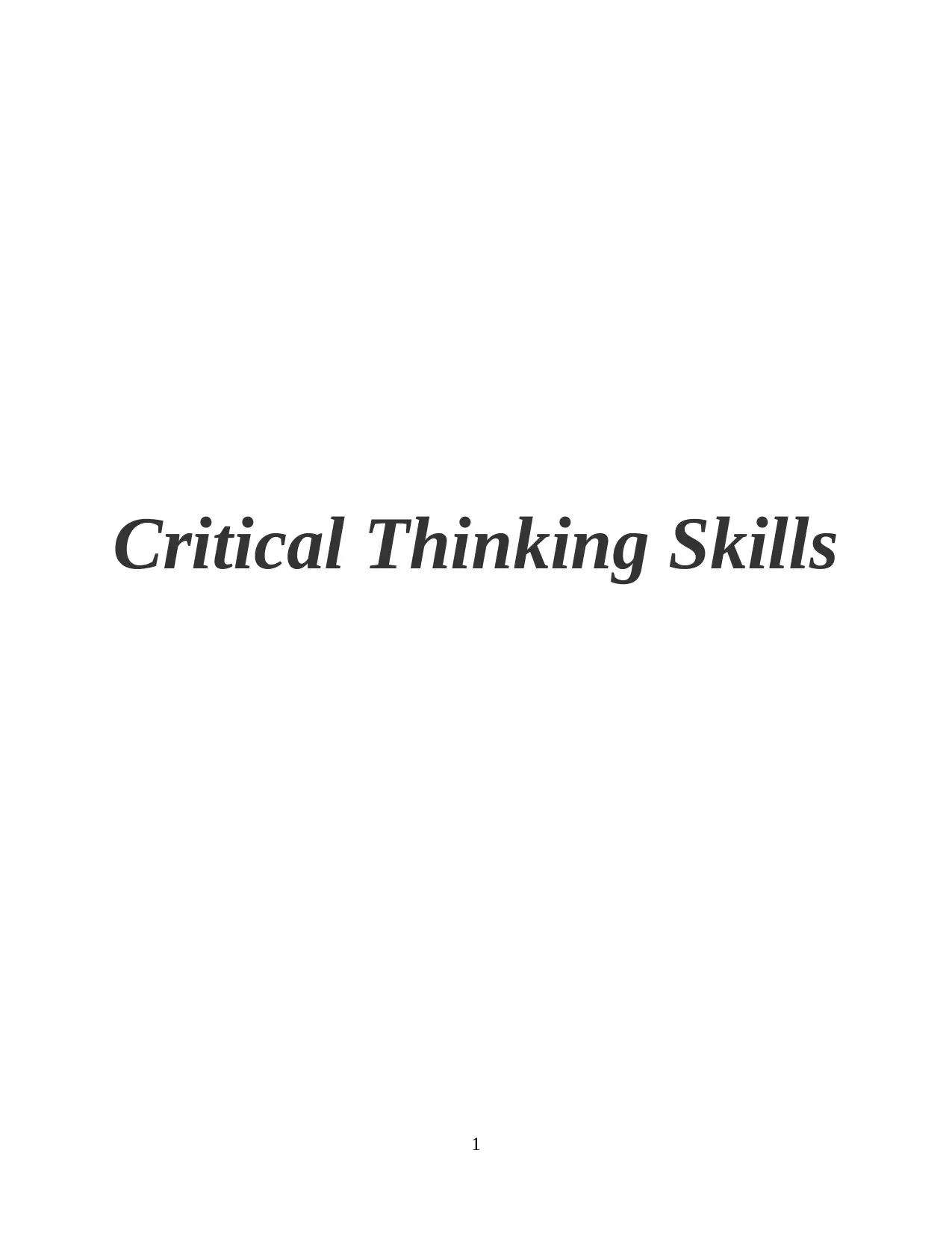
Critical Thinking Skills
1
1
Paraphrase This Document
Need a fresh take? Get an instant paraphrase of this document with our AI Paraphraser
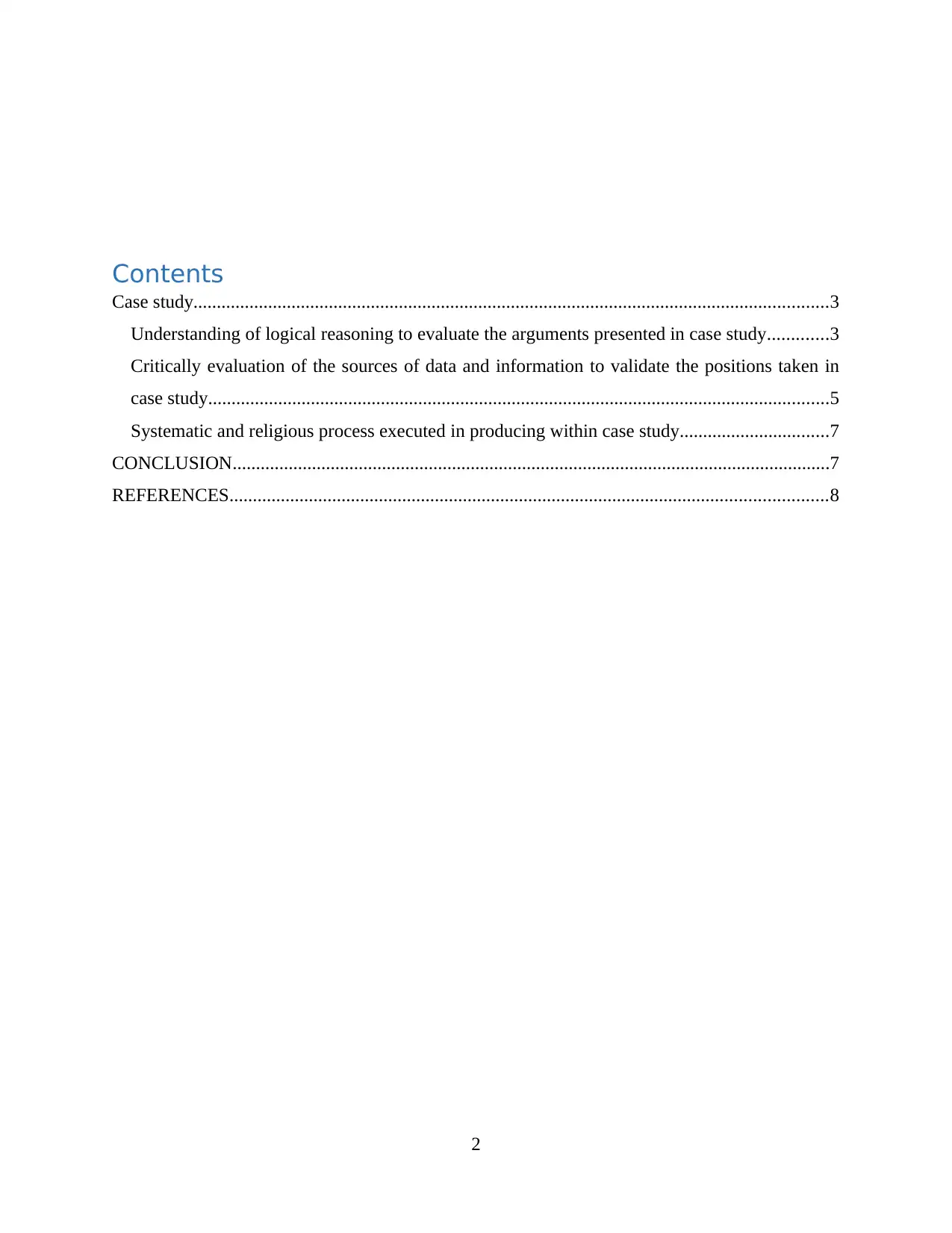
Contents
Case study........................................................................................................................................3
Understanding of logical reasoning to evaluate the arguments presented in case study.............3
Critically evaluation of the sources of data and information to validate the positions taken in
case study.....................................................................................................................................5
Systematic and religious process executed in producing within case study................................7
CONCLUSION................................................................................................................................7
REFERENCES................................................................................................................................8
2
Case study........................................................................................................................................3
Understanding of logical reasoning to evaluate the arguments presented in case study.............3
Critically evaluation of the sources of data and information to validate the positions taken in
case study.....................................................................................................................................5
Systematic and religious process executed in producing within case study................................7
CONCLUSION................................................................................................................................7
REFERENCES................................................................................................................................8
2
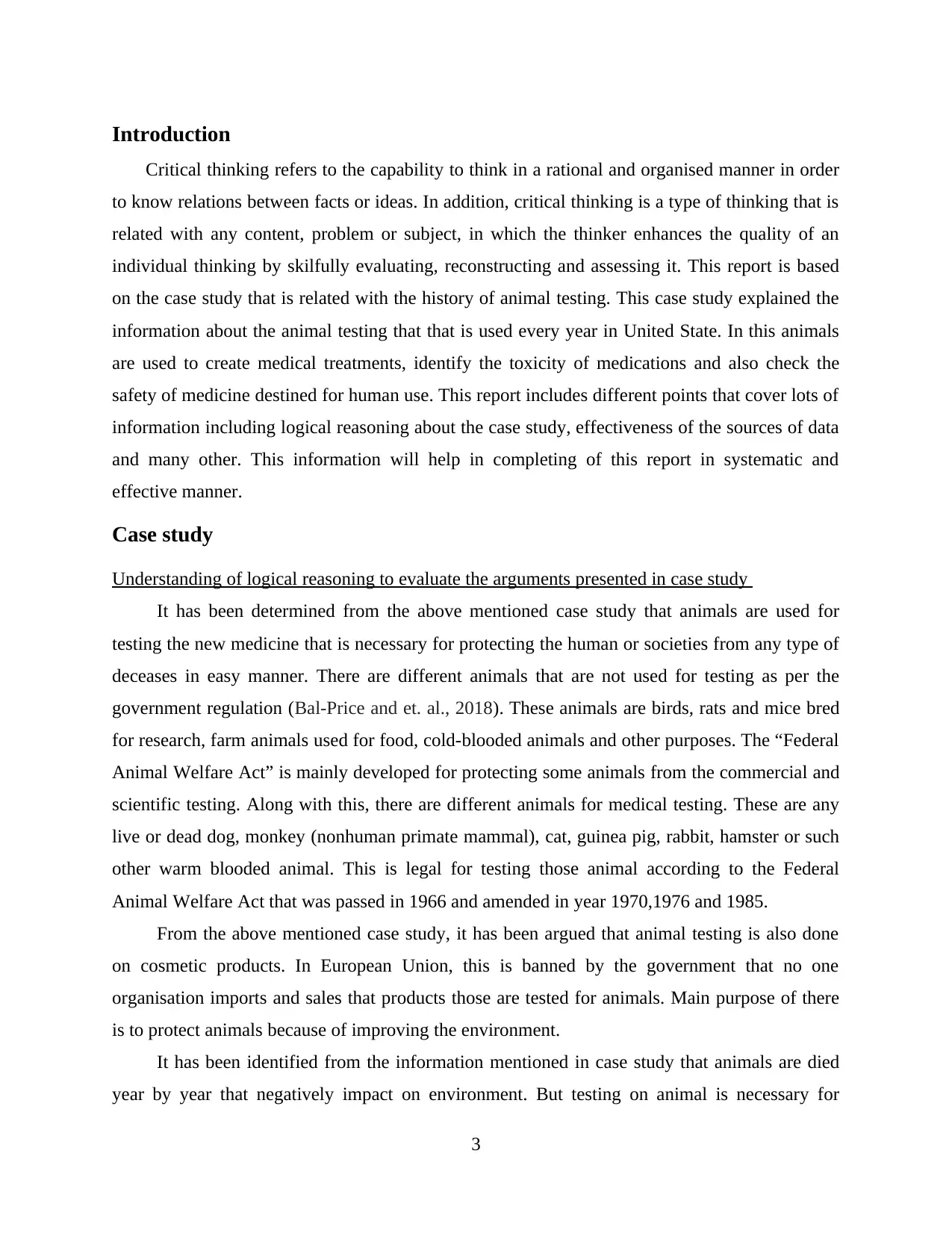
Introduction
Critical thinking refers to the capability to think in a rational and organised manner in order
to know relations between facts or ideas. In addition, critical thinking is a type of thinking that is
related with any content, problem or subject, in which the thinker enhances the quality of an
individual thinking by skilfully evaluating, reconstructing and assessing it. This report is based
on the case study that is related with the history of animal testing. This case study explained the
information about the animal testing that that is used every year in United State. In this animals
are used to create medical treatments, identify the toxicity of medications and also check the
safety of medicine destined for human use. This report includes different points that cover lots of
information including logical reasoning about the case study, effectiveness of the sources of data
and many other. This information will help in completing of this report in systematic and
effective manner.
Case study
Understanding of logical reasoning to evaluate the arguments presented in case study
It has been determined from the above mentioned case study that animals are used for
testing the new medicine that is necessary for protecting the human or societies from any type of
deceases in easy manner. There are different animals that are not used for testing as per the
government regulation (Bal-Price and et. al., 2018). These animals are birds, rats and mice bred
for research, farm animals used for food, cold-blooded animals and other purposes. The “Federal
Animal Welfare Act” is mainly developed for protecting some animals from the commercial and
scientific testing. Along with this, there are different animals for medical testing. These are any
live or dead dog, monkey (nonhuman primate mammal), cat, guinea pig, rabbit, hamster or such
other warm blooded animal. This is legal for testing those animal according to the Federal
Animal Welfare Act that was passed in 1966 and amended in year 1970,1976 and 1985.
From the above mentioned case study, it has been argued that animal testing is also done
on cosmetic products. In European Union, this is banned by the government that no one
organisation imports and sales that products those are tested for animals. Main purpose of there
is to protect animals because of improving the environment.
It has been identified from the information mentioned in case study that animals are died
year by year that negatively impact on environment. But testing on animal is necessary for
3
Critical thinking refers to the capability to think in a rational and organised manner in order
to know relations between facts or ideas. In addition, critical thinking is a type of thinking that is
related with any content, problem or subject, in which the thinker enhances the quality of an
individual thinking by skilfully evaluating, reconstructing and assessing it. This report is based
on the case study that is related with the history of animal testing. This case study explained the
information about the animal testing that that is used every year in United State. In this animals
are used to create medical treatments, identify the toxicity of medications and also check the
safety of medicine destined for human use. This report includes different points that cover lots of
information including logical reasoning about the case study, effectiveness of the sources of data
and many other. This information will help in completing of this report in systematic and
effective manner.
Case study
Understanding of logical reasoning to evaluate the arguments presented in case study
It has been determined from the above mentioned case study that animals are used for
testing the new medicine that is necessary for protecting the human or societies from any type of
deceases in easy manner. There are different animals that are not used for testing as per the
government regulation (Bal-Price and et. al., 2018). These animals are birds, rats and mice bred
for research, farm animals used for food, cold-blooded animals and other purposes. The “Federal
Animal Welfare Act” is mainly developed for protecting some animals from the commercial and
scientific testing. Along with this, there are different animals for medical testing. These are any
live or dead dog, monkey (nonhuman primate mammal), cat, guinea pig, rabbit, hamster or such
other warm blooded animal. This is legal for testing those animal according to the Federal
Animal Welfare Act that was passed in 1966 and amended in year 1970,1976 and 1985.
From the above mentioned case study, it has been argued that animal testing is also done
on cosmetic products. In European Union, this is banned by the government that no one
organisation imports and sales that products those are tested for animals. Main purpose of there
is to protect animals because of improving the environment.
It has been identified from the information mentioned in case study that animals are died
year by year that negatively impact on environment. But testing on animal is necessary for
3
⊘ This is a preview!⊘
Do you want full access?
Subscribe today to unlock all pages.

Trusted by 1+ million students worldwide
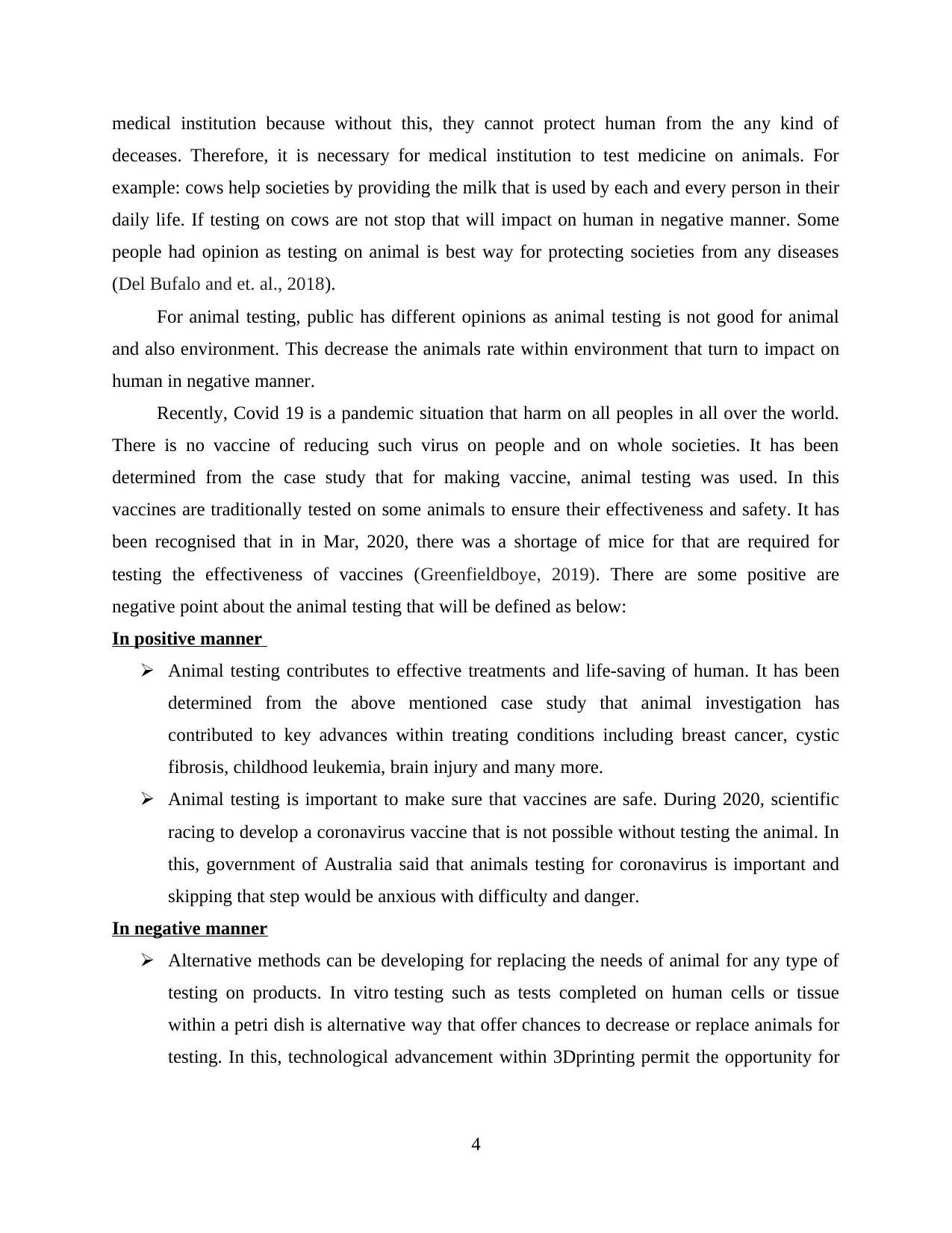
medical institution because without this, they cannot protect human from the any kind of
deceases. Therefore, it is necessary for medical institution to test medicine on animals. For
example: cows help societies by providing the milk that is used by each and every person in their
daily life. If testing on cows are not stop that will impact on human in negative manner. Some
people had opinion as testing on animal is best way for protecting societies from any diseases
(Del Bufalo and et. al., 2018).
For animal testing, public has different opinions as animal testing is not good for animal
and also environment. This decrease the animals rate within environment that turn to impact on
human in negative manner.
Recently, Covid 19 is a pandemic situation that harm on all peoples in all over the world.
There is no vaccine of reducing such virus on people and on whole societies. It has been
determined from the case study that for making vaccine, animal testing was used. In this
vaccines are traditionally tested on some animals to ensure their effectiveness and safety. It has
been recognised that in in Mar, 2020, there was a shortage of mice for that are required for
testing the effectiveness of vaccines (Greenfieldboye, 2019). There are some positive are
negative point about the animal testing that will be defined as below:
In positive manner
Animal testing contributes to effective treatments and life-saving of human. It has been
determined from the above mentioned case study that animal investigation has
contributed to key advances within treating conditions including breast cancer, cystic
fibrosis, childhood leukemia, brain injury and many more.
Animal testing is important to make sure that vaccines are safe. During 2020, scientific
racing to develop a coronavirus vaccine that is not possible without testing the animal. In
this, government of Australia said that animals testing for coronavirus is important and
skipping that step would be anxious with difficulty and danger.
In negative manner
Alternative methods can be developing for replacing the needs of animal for any type of
testing on products. In vitro testing such as tests completed on human cells or tissue
within a petri dish is alternative way that offer chances to decrease or replace animals for
testing. In this, technological advancement within 3Dprinting permit the opportunity for
4
deceases. Therefore, it is necessary for medical institution to test medicine on animals. For
example: cows help societies by providing the milk that is used by each and every person in their
daily life. If testing on cows are not stop that will impact on human in negative manner. Some
people had opinion as testing on animal is best way for protecting societies from any diseases
(Del Bufalo and et. al., 2018).
For animal testing, public has different opinions as animal testing is not good for animal
and also environment. This decrease the animals rate within environment that turn to impact on
human in negative manner.
Recently, Covid 19 is a pandemic situation that harm on all peoples in all over the world.
There is no vaccine of reducing such virus on people and on whole societies. It has been
determined from the case study that for making vaccine, animal testing was used. In this
vaccines are traditionally tested on some animals to ensure their effectiveness and safety. It has
been recognised that in in Mar, 2020, there was a shortage of mice for that are required for
testing the effectiveness of vaccines (Greenfieldboye, 2019). There are some positive are
negative point about the animal testing that will be defined as below:
In positive manner
Animal testing contributes to effective treatments and life-saving of human. It has been
determined from the above mentioned case study that animal investigation has
contributed to key advances within treating conditions including breast cancer, cystic
fibrosis, childhood leukemia, brain injury and many more.
Animal testing is important to make sure that vaccines are safe. During 2020, scientific
racing to develop a coronavirus vaccine that is not possible without testing the animal. In
this, government of Australia said that animals testing for coronavirus is important and
skipping that step would be anxious with difficulty and danger.
In negative manner
Alternative methods can be developing for replacing the needs of animal for any type of
testing on products. In vitro testing such as tests completed on human cells or tissue
within a petri dish is alternative way that offer chances to decrease or replace animals for
testing. In this, technological advancement within 3Dprinting permit the opportunity for
4
Paraphrase This Document
Need a fresh take? Get an instant paraphrase of this document with our AI Paraphraser
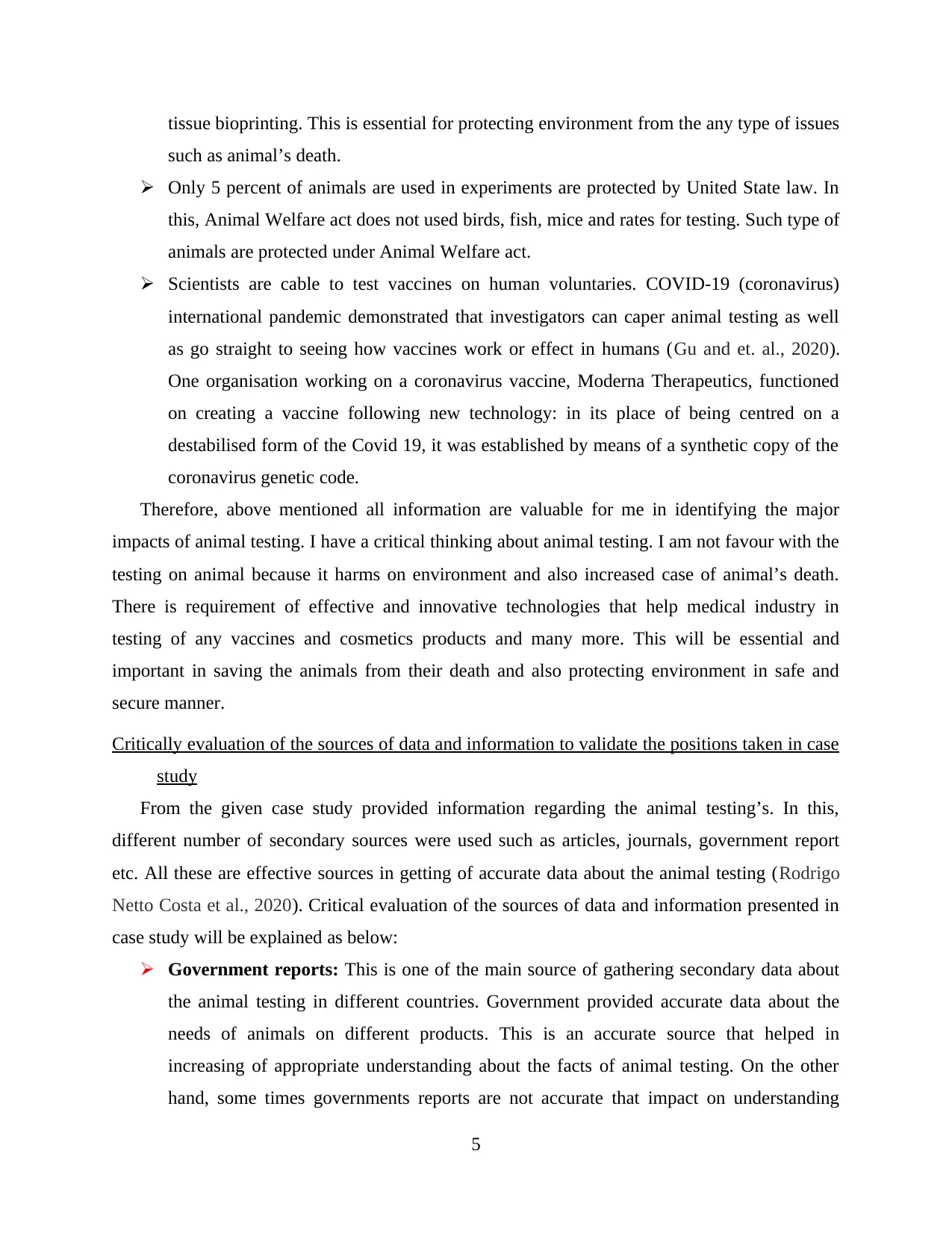
tissue bioprinting. This is essential for protecting environment from the any type of issues
such as animal’s death.
Only 5 percent of animals are used in experiments are protected by United State law. In
this, Animal Welfare act does not used birds, fish, mice and rates for testing. Such type of
animals are protected under Animal Welfare act.
Scientists are cable to test vaccines on human voluntaries. COVID-19 (coronavirus)
international pandemic demonstrated that investigators can caper animal testing as well
as go straight to seeing how vaccines work or effect in humans (Gu and et. al., 2020).
One organisation working on a coronavirus vaccine, Moderna Therapeutics, functioned
on creating a vaccine following new technology: in its place of being centred on a
destabilised form of the Covid 19, it was established by means of a synthetic copy of the
coronavirus genetic code.
Therefore, above mentioned all information are valuable for me in identifying the major
impacts of animal testing. I have a critical thinking about animal testing. I am not favour with the
testing on animal because it harms on environment and also increased case of animal’s death.
There is requirement of effective and innovative technologies that help medical industry in
testing of any vaccines and cosmetics products and many more. This will be essential and
important in saving the animals from their death and also protecting environment in safe and
secure manner.
Critically evaluation of the sources of data and information to validate the positions taken in case
study
From the given case study provided information regarding the animal testing’s. In this,
different number of secondary sources were used such as articles, journals, government report
etc. All these are effective sources in getting of accurate data about the animal testing (Rodrigo
Netto Costa et al., 2020). Critical evaluation of the sources of data and information presented in
case study will be explained as below:
Government reports: This is one of the main source of gathering secondary data about
the animal testing in different countries. Government provided accurate data about the
needs of animals on different products. This is an accurate source that helped in
increasing of appropriate understanding about the facts of animal testing. On the other
hand, some times governments reports are not accurate that impact on understanding
5
such as animal’s death.
Only 5 percent of animals are used in experiments are protected by United State law. In
this, Animal Welfare act does not used birds, fish, mice and rates for testing. Such type of
animals are protected under Animal Welfare act.
Scientists are cable to test vaccines on human voluntaries. COVID-19 (coronavirus)
international pandemic demonstrated that investigators can caper animal testing as well
as go straight to seeing how vaccines work or effect in humans (Gu and et. al., 2020).
One organisation working on a coronavirus vaccine, Moderna Therapeutics, functioned
on creating a vaccine following new technology: in its place of being centred on a
destabilised form of the Covid 19, it was established by means of a synthetic copy of the
coronavirus genetic code.
Therefore, above mentioned all information are valuable for me in identifying the major
impacts of animal testing. I have a critical thinking about animal testing. I am not favour with the
testing on animal because it harms on environment and also increased case of animal’s death.
There is requirement of effective and innovative technologies that help medical industry in
testing of any vaccines and cosmetics products and many more. This will be essential and
important in saving the animals from their death and also protecting environment in safe and
secure manner.
Critically evaluation of the sources of data and information to validate the positions taken in case
study
From the given case study provided information regarding the animal testing’s. In this,
different number of secondary sources were used such as articles, journals, government report
etc. All these are effective sources in getting of accurate data about the animal testing (Rodrigo
Netto Costa et al., 2020). Critical evaluation of the sources of data and information presented in
case study will be explained as below:
Government reports: This is one of the main source of gathering secondary data about
the animal testing in different countries. Government provided accurate data about the
needs of animals on different products. This is an accurate source that helped in
increasing of appropriate understanding about the facts of animal testing. On the other
hand, some times governments reports are not accurate that impact on understanding
5
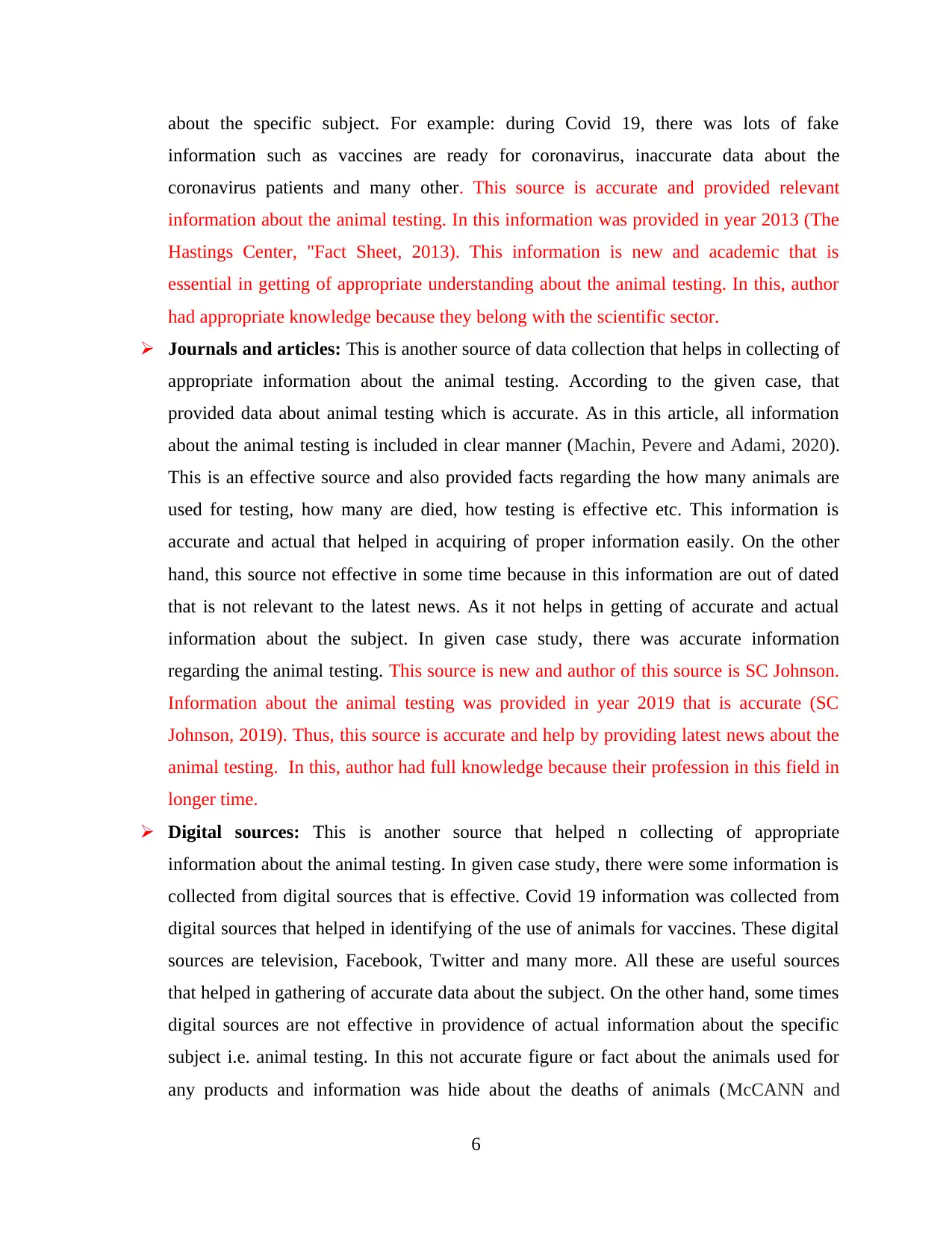
about the specific subject. For example: during Covid 19, there was lots of fake
information such as vaccines are ready for coronavirus, inaccurate data about the
coronavirus patients and many other. This source is accurate and provided relevant
information about the animal testing. In this information was provided in year 2013 (The
Hastings Center, "Fact Sheet, 2013). This information is new and academic that is
essential in getting of appropriate understanding about the animal testing. In this, author
had appropriate knowledge because they belong with the scientific sector.
Journals and articles: This is another source of data collection that helps in collecting of
appropriate information about the animal testing. According to the given case, that
provided data about animal testing which is accurate. As in this article, all information
about the animal testing is included in clear manner (Machin, Pevere and Adami, 2020).
This is an effective source and also provided facts regarding the how many animals are
used for testing, how many are died, how testing is effective etc. This information is
accurate and actual that helped in acquiring of proper information easily. On the other
hand, this source not effective in some time because in this information are out of dated
that is not relevant to the latest news. As it not helps in getting of accurate and actual
information about the subject. In given case study, there was accurate information
regarding the animal testing. This source is new and author of this source is SC Johnson.
Information about the animal testing was provided in year 2019 that is accurate (SC
Johnson, 2019). Thus, this source is accurate and help by providing latest news about the
animal testing. In this, author had full knowledge because their profession in this field in
longer time.
Digital sources: This is another source that helped n collecting of appropriate
information about the animal testing. In given case study, there were some information is
collected from digital sources that is effective. Covid 19 information was collected from
digital sources that helped in identifying of the use of animals for vaccines. These digital
sources are television, Facebook, Twitter and many more. All these are useful sources
that helped in gathering of accurate data about the subject. On the other hand, some times
digital sources are not effective in providence of actual information about the specific
subject i.e. animal testing. In this not accurate figure or fact about the animals used for
any products and information was hide about the deaths of animals (McCANN and
6
information such as vaccines are ready for coronavirus, inaccurate data about the
coronavirus patients and many other. This source is accurate and provided relevant
information about the animal testing. In this information was provided in year 2013 (The
Hastings Center, "Fact Sheet, 2013). This information is new and academic that is
essential in getting of appropriate understanding about the animal testing. In this, author
had appropriate knowledge because they belong with the scientific sector.
Journals and articles: This is another source of data collection that helps in collecting of
appropriate information about the animal testing. According to the given case, that
provided data about animal testing which is accurate. As in this article, all information
about the animal testing is included in clear manner (Machin, Pevere and Adami, 2020).
This is an effective source and also provided facts regarding the how many animals are
used for testing, how many are died, how testing is effective etc. This information is
accurate and actual that helped in acquiring of proper information easily. On the other
hand, this source not effective in some time because in this information are out of dated
that is not relevant to the latest news. As it not helps in getting of accurate and actual
information about the subject. In given case study, there was accurate information
regarding the animal testing. This source is new and author of this source is SC Johnson.
Information about the animal testing was provided in year 2019 that is accurate (SC
Johnson, 2019). Thus, this source is accurate and help by providing latest news about the
animal testing. In this, author had full knowledge because their profession in this field in
longer time.
Digital sources: This is another source that helped n collecting of appropriate
information about the animal testing. In given case study, there were some information is
collected from digital sources that is effective. Covid 19 information was collected from
digital sources that helped in identifying of the use of animals for vaccines. These digital
sources are television, Facebook, Twitter and many more. All these are useful sources
that helped in gathering of accurate data about the subject. On the other hand, some times
digital sources are not effective in providence of actual information about the specific
subject i.e. animal testing. In this not accurate figure or fact about the animals used for
any products and information was hide about the deaths of animals (McCANN and
6
⊘ This is a preview!⊘
Do you want full access?
Subscribe today to unlock all pages.

Trusted by 1+ million students worldwide
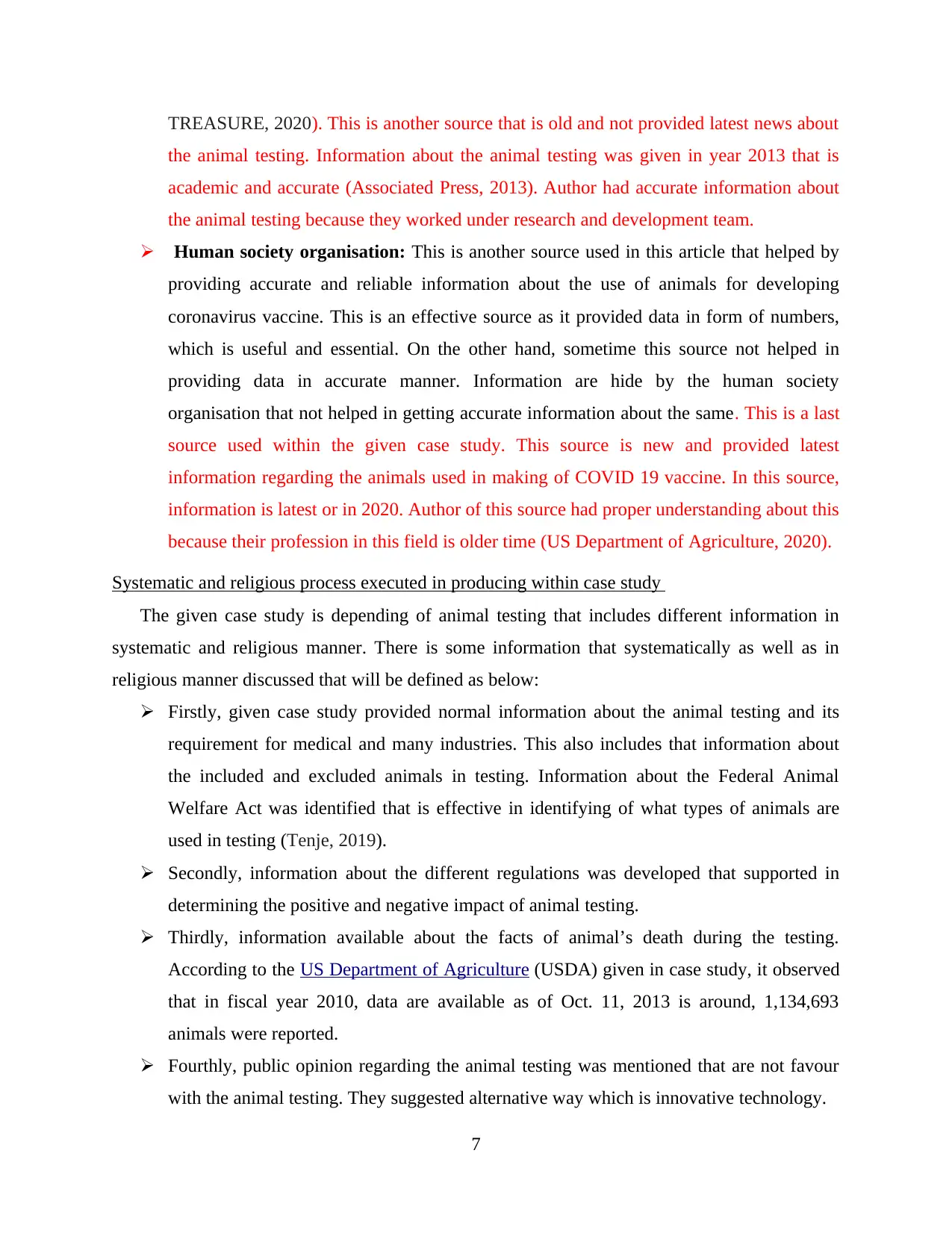
TREASURE, 2020). This is another source that is old and not provided latest news about
the animal testing. Information about the animal testing was given in year 2013 that is
academic and accurate (Associated Press, 2013). Author had accurate information about
the animal testing because they worked under research and development team.
Human society organisation: This is another source used in this article that helped by
providing accurate and reliable information about the use of animals for developing
coronavirus vaccine. This is an effective source as it provided data in form of numbers,
which is useful and essential. On the other hand, sometime this source not helped in
providing data in accurate manner. Information are hide by the human society
organisation that not helped in getting accurate information about the same. This is a last
source used within the given case study. This source is new and provided latest
information regarding the animals used in making of COVID 19 vaccine. In this source,
information is latest or in 2020. Author of this source had proper understanding about this
because their profession in this field is older time (US Department of Agriculture, 2020).
Systematic and religious process executed in producing within case study
The given case study is depending of animal testing that includes different information in
systematic and religious manner. There is some information that systematically as well as in
religious manner discussed that will be defined as below:
Firstly, given case study provided normal information about the animal testing and its
requirement for medical and many industries. This also includes that information about
the included and excluded animals in testing. Information about the Federal Animal
Welfare Act was identified that is effective in identifying of what types of animals are
used in testing (Tenje, 2019).
Secondly, information about the different regulations was developed that supported in
determining the positive and negative impact of animal testing.
Thirdly, information available about the facts of animal’s death during the testing.
According to the US Department of Agriculture (USDA) given in case study, it observed
that in fiscal year 2010, data are available as of Oct. 11, 2013 is around, 1,134,693
animals were reported.
Fourthly, public opinion regarding the animal testing was mentioned that are not favour
with the animal testing. They suggested alternative way which is innovative technology.
7
the animal testing. Information about the animal testing was given in year 2013 that is
academic and accurate (Associated Press, 2013). Author had accurate information about
the animal testing because they worked under research and development team.
Human society organisation: This is another source used in this article that helped by
providing accurate and reliable information about the use of animals for developing
coronavirus vaccine. This is an effective source as it provided data in form of numbers,
which is useful and essential. On the other hand, sometime this source not helped in
providing data in accurate manner. Information are hide by the human society
organisation that not helped in getting accurate information about the same. This is a last
source used within the given case study. This source is new and provided latest
information regarding the animals used in making of COVID 19 vaccine. In this source,
information is latest or in 2020. Author of this source had proper understanding about this
because their profession in this field is older time (US Department of Agriculture, 2020).
Systematic and religious process executed in producing within case study
The given case study is depending of animal testing that includes different information in
systematic and religious manner. There is some information that systematically as well as in
religious manner discussed that will be defined as below:
Firstly, given case study provided normal information about the animal testing and its
requirement for medical and many industries. This also includes that information about
the included and excluded animals in testing. Information about the Federal Animal
Welfare Act was identified that is effective in identifying of what types of animals are
used in testing (Tenje, 2019).
Secondly, information about the different regulations was developed that supported in
determining the positive and negative impact of animal testing.
Thirdly, information available about the facts of animal’s death during the testing.
According to the US Department of Agriculture (USDA) given in case study, it observed
that in fiscal year 2010, data are available as of Oct. 11, 2013 is around, 1,134,693
animals were reported.
Fourthly, public opinion regarding the animal testing was mentioned that are not favour
with the animal testing. They suggested alternative way which is innovative technology.
7
Paraphrase This Document
Need a fresh take? Get an instant paraphrase of this document with our AI Paraphraser
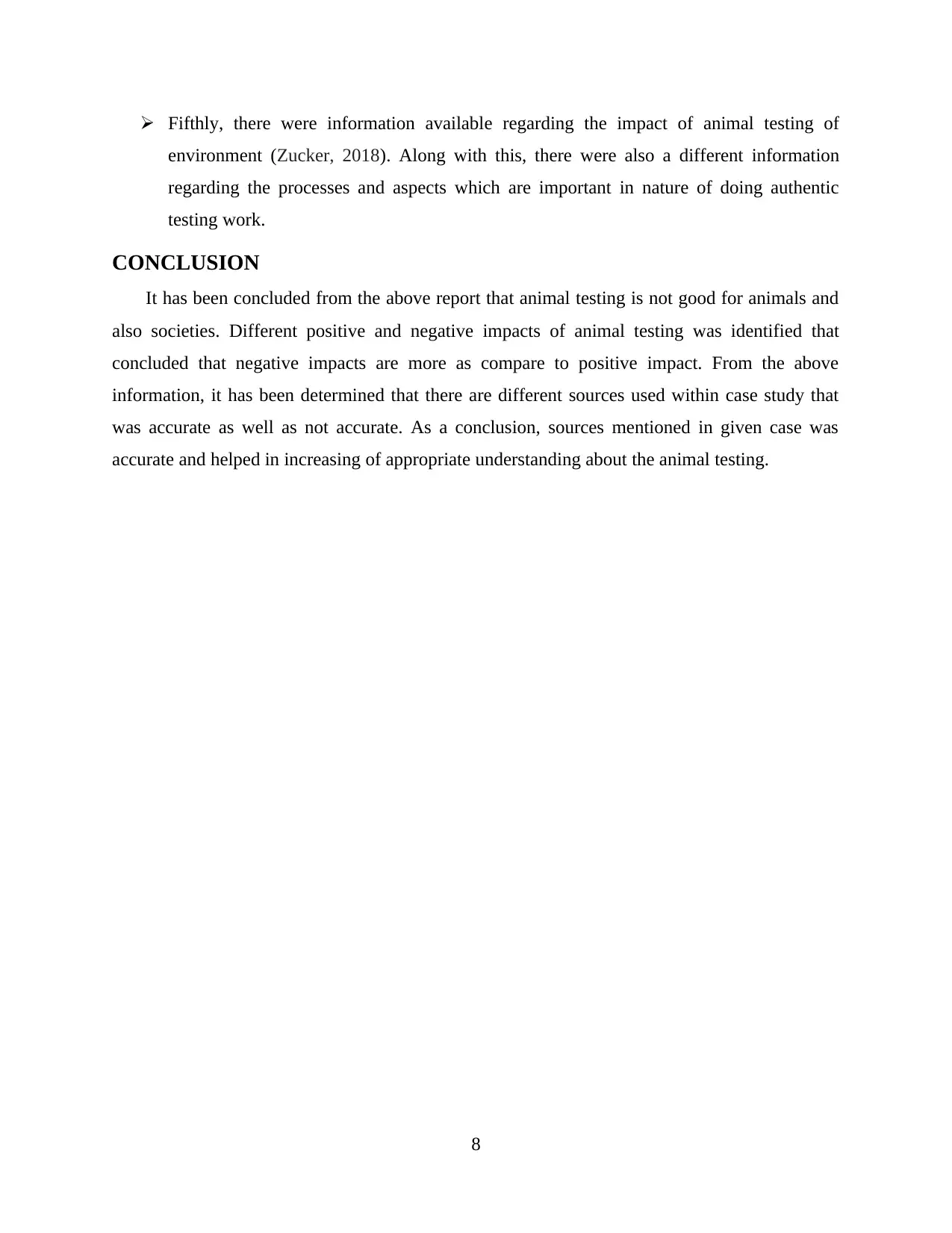
Fifthly, there were information available regarding the impact of animal testing of
environment (Zucker, 2018). Along with this, there were also a different information
regarding the processes and aspects which are important in nature of doing authentic
testing work.
CONCLUSION
It has been concluded from the above report that animal testing is not good for animals and
also societies. Different positive and negative impacts of animal testing was identified that
concluded that negative impacts are more as compare to positive impact. From the above
information, it has been determined that there are different sources used within case study that
was accurate as well as not accurate. As a conclusion, sources mentioned in given case was
accurate and helped in increasing of appropriate understanding about the animal testing.
8
environment (Zucker, 2018). Along with this, there were also a different information
regarding the processes and aspects which are important in nature of doing authentic
testing work.
CONCLUSION
It has been concluded from the above report that animal testing is not good for animals and
also societies. Different positive and negative impacts of animal testing was identified that
concluded that negative impacts are more as compare to positive impact. From the above
information, it has been determined that there are different sources used within case study that
was accurate as well as not accurate. As a conclusion, sources mentioned in given case was
accurate and helped in increasing of appropriate understanding about the animal testing.
8
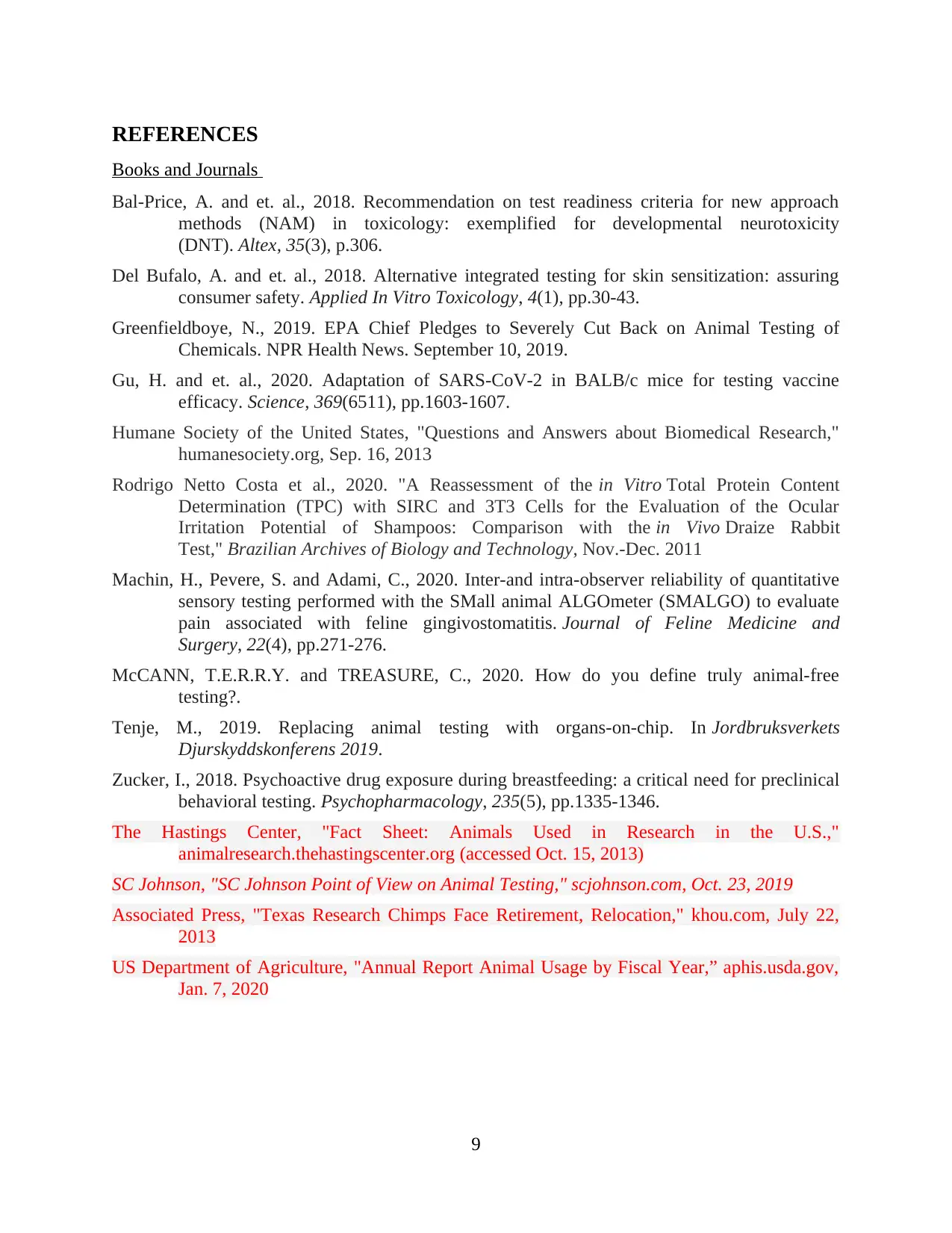
REFERENCES
Books and Journals
Bal-Price, A. and et. al., 2018. Recommendation on test readiness criteria for new approach
methods (NAM) in toxicology: exemplified for developmental neurotoxicity
(DNT). Altex, 35(3), p.306.
Del Bufalo, A. and et. al., 2018. Alternative integrated testing for skin sensitization: assuring
consumer safety. Applied In Vitro Toxicology, 4(1), pp.30-43.
Greenfieldboye, N., 2019. EPA Chief Pledges to Severely Cut Back on Animal Testing of
Chemicals. NPR Health News. September 10, 2019.
Gu, H. and et. al., 2020. Adaptation of SARS-CoV-2 in BALB/c mice for testing vaccine
efficacy. Science, 369(6511), pp.1603-1607.
Humane Society of the United States, "Questions and Answers about Biomedical Research,"
humanesociety.org, Sep. 16, 2013
Rodrigo Netto Costa et al., 2020. "A Reassessment of the in Vitro Total Protein Content
Determination (TPC) with SIRC and 3T3 Cells for the Evaluation of the Ocular
Irritation Potential of Shampoos: Comparison with the in Vivo Draize Rabbit
Test," Brazilian Archives of Biology and Technology, Nov.-Dec. 2011
Machin, H., Pevere, S. and Adami, C., 2020. Inter-and intra-observer reliability of quantitative
sensory testing performed with the SMall animal ALGOmeter (SMALGO) to evaluate
pain associated with feline gingivostomatitis. Journal of Feline Medicine and
Surgery, 22(4), pp.271-276.
McCANN, T.E.R.R.Y. and TREASURE, C., 2020. How do you define truly animal-free
testing?.
Tenje, M., 2019. Replacing animal testing with organs-on-chip. In Jordbruksverkets
Djurskyddskonferens 2019.
Zucker, I., 2018. Psychoactive drug exposure during breastfeeding: a critical need for preclinical
behavioral testing. Psychopharmacology, 235(5), pp.1335-1346.
The Hastings Center, "Fact Sheet: Animals Used in Research in the U.S.,"
animalresearch.thehastingscenter.org (accessed Oct. 15, 2013)
SC Johnson, "SC Johnson Point of View on Animal Testing," scjohnson.com, Oct. 23, 2019
Associated Press, "Texas Research Chimps Face Retirement, Relocation," khou.com, July 22,
2013
US Department of Agriculture, "Annual Report Animal Usage by Fiscal Year,” aphis.usda.gov,
Jan. 7, 2020
9
Books and Journals
Bal-Price, A. and et. al., 2018. Recommendation on test readiness criteria for new approach
methods (NAM) in toxicology: exemplified for developmental neurotoxicity
(DNT). Altex, 35(3), p.306.
Del Bufalo, A. and et. al., 2018. Alternative integrated testing for skin sensitization: assuring
consumer safety. Applied In Vitro Toxicology, 4(1), pp.30-43.
Greenfieldboye, N., 2019. EPA Chief Pledges to Severely Cut Back on Animal Testing of
Chemicals. NPR Health News. September 10, 2019.
Gu, H. and et. al., 2020. Adaptation of SARS-CoV-2 in BALB/c mice for testing vaccine
efficacy. Science, 369(6511), pp.1603-1607.
Humane Society of the United States, "Questions and Answers about Biomedical Research,"
humanesociety.org, Sep. 16, 2013
Rodrigo Netto Costa et al., 2020. "A Reassessment of the in Vitro Total Protein Content
Determination (TPC) with SIRC and 3T3 Cells for the Evaluation of the Ocular
Irritation Potential of Shampoos: Comparison with the in Vivo Draize Rabbit
Test," Brazilian Archives of Biology and Technology, Nov.-Dec. 2011
Machin, H., Pevere, S. and Adami, C., 2020. Inter-and intra-observer reliability of quantitative
sensory testing performed with the SMall animal ALGOmeter (SMALGO) to evaluate
pain associated with feline gingivostomatitis. Journal of Feline Medicine and
Surgery, 22(4), pp.271-276.
McCANN, T.E.R.R.Y. and TREASURE, C., 2020. How do you define truly animal-free
testing?.
Tenje, M., 2019. Replacing animal testing with organs-on-chip. In Jordbruksverkets
Djurskyddskonferens 2019.
Zucker, I., 2018. Psychoactive drug exposure during breastfeeding: a critical need for preclinical
behavioral testing. Psychopharmacology, 235(5), pp.1335-1346.
The Hastings Center, "Fact Sheet: Animals Used in Research in the U.S.,"
animalresearch.thehastingscenter.org (accessed Oct. 15, 2013)
SC Johnson, "SC Johnson Point of View on Animal Testing," scjohnson.com, Oct. 23, 2019
Associated Press, "Texas Research Chimps Face Retirement, Relocation," khou.com, July 22,
2013
US Department of Agriculture, "Annual Report Animal Usage by Fiscal Year,” aphis.usda.gov,
Jan. 7, 2020
9
⊘ This is a preview!⊘
Do you want full access?
Subscribe today to unlock all pages.

Trusted by 1+ million students worldwide
1 out of 9
Related Documents
Your All-in-One AI-Powered Toolkit for Academic Success.
+13062052269
info@desklib.com
Available 24*7 on WhatsApp / Email
![[object Object]](/_next/static/media/star-bottom.7253800d.svg)
Unlock your academic potential
Copyright © 2020–2025 A2Z Services. All Rights Reserved. Developed and managed by ZUCOL.





